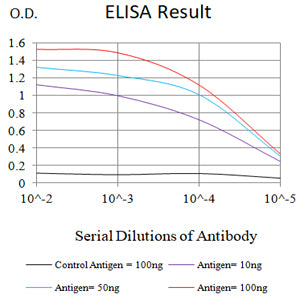
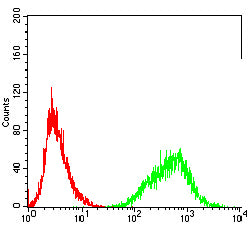

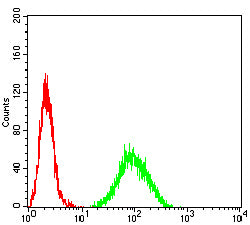
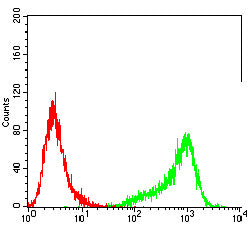
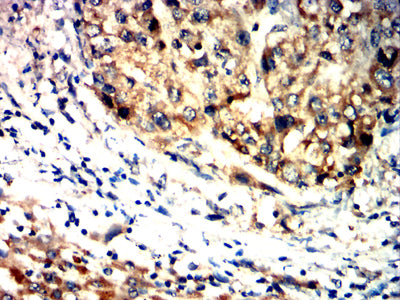
| WB | 咨询技术 | Human,Mouse,Rat |
| IF | 咨询技术 | Human,Mouse,Rat |
| IHC | 1/200 - 1/1000 | Human,Mouse,Rat |
| ICC | 技术咨询 | Human,Mouse,Rat |
| FCM | 1/200 - 1/400 | Human,Mouse,Rat |
| Elisa | 1/10000 | Human,Mouse,Rat |
| Aliases | HLALS |
| Entrez GeneID | 3140 |
| clone | 6A5B2 |
| WB Predicted band size | 39.4kda |
| Host/Isotype | Mouse IgG2a |
| Antibody Type | Primary antibody |
| Storage | Store at 4°C short term. Aliquot and store at -20°C long term. Avoid freeze/thaw cycles. |
| Species Reactivity | Human |
| Immunogen | Purified recombinant fragment of human MR1 (AA: extra(23-302)) expressed in E. Coli. |
| Formulation | Purified antibody in PBS with 0.05% sodium azide |
+ +
以下是关于MR1抗体的3篇参考文献及其摘要概括:
---
1. **文献名称**:*MR1 presents microbial vitamin B metabolites to MAIT cells*
**作者**:Kjer-Nielsen, L. et al.
**摘要**:该研究揭示了MR1分子通过结合微生物代谢产生的维生素B衍生物,激活MAIT(黏膜相关恒定T)细胞的分子机制,并开发了特异性抗体用于检测MR1-抗原复合物。
2. **文献名称**:*Antibody-mediated detection of MR1 reveals its subcellular localization and tissue expression pattern*
**作者**:McWilliam, H.E.G. et al.
**摘要**:作者利用新型MR1特异性抗体,系统分析了MR1在人体组织中的分布及亚细胞定位,证实其在黏膜屏障和免疫细胞中的广泛表达,并探讨了其在病原体监测中的作用。
3. **文献名称**:*MR1-restricted T cells in antibacterial immunity and immune pathology*
**作者**:Gold, M.C. & Lewinsohn, D.M.
**摘要**:本文综述了MR1限制性T细胞(如MAIT细胞)在抗感染免疫中的功能,并强调了MR1抗体在研究其激活机制及与结核分枝杆菌等病原体互作中的应用。
---
**备注**:以上文献均聚焦于MR1分子的免疫学功能及其抗体的研究工具价值,涵盖结构机制、组织分布及疾病相关性等领域。如需具体文章年份或期刊信息,可进一步补充检索关键词(如“MR1 antibody structure”或“MR1 cancer immunotherapy”)。
MR1 (MHC class I-related molecule 1) is a highly conserved antigen-presenting molecule that binds microbial vitamin B2 (riboflavin) precursor derivatives, enabling recognition by mucosal-associated invariant T (MAIT) cells. Discovered in the 1990s, MR1 differs from classical MHC-I molecules as it is non-polymorphic and presents metabolites rather than peptide antigens. Its interaction with MAIT cells, a subset of innate-like T cells abundant in mucosal tissues, plays a critical role in bridging innate and adaptive immunity against bacterial and fungal infections.
MR1-specific antibodies have emerged as valuable tools to study MR1's biology and therapeutic potential. Early antibodies like 26.5 and 8F2.F9 facilitated the identification of MR1's expression on antigen-presenting cells and its role in MAIT cell activation. More recently, antibodies such as clone 12.2 have been used to block MR1-antigen presentation, elucidating its involvement in infections, cancer, and autoimmune diseases. In oncology, anti-MR1 antibodies are explored for their ability to modulate MAIT cell responses, as MR1 is often overexpressed on tumor cells. Conversely, agonist antibodies may enhance antimicrobial immunity by boosting MAIT cell activity. Current research also investigates MR1-targeting bispecific antibodies for precision immunotherapy. Despite progress, challenges remain in understanding MR1's ligand diversity and tissue-specific regulation, driving ongoing development of advanced antibody-based reagents.
×